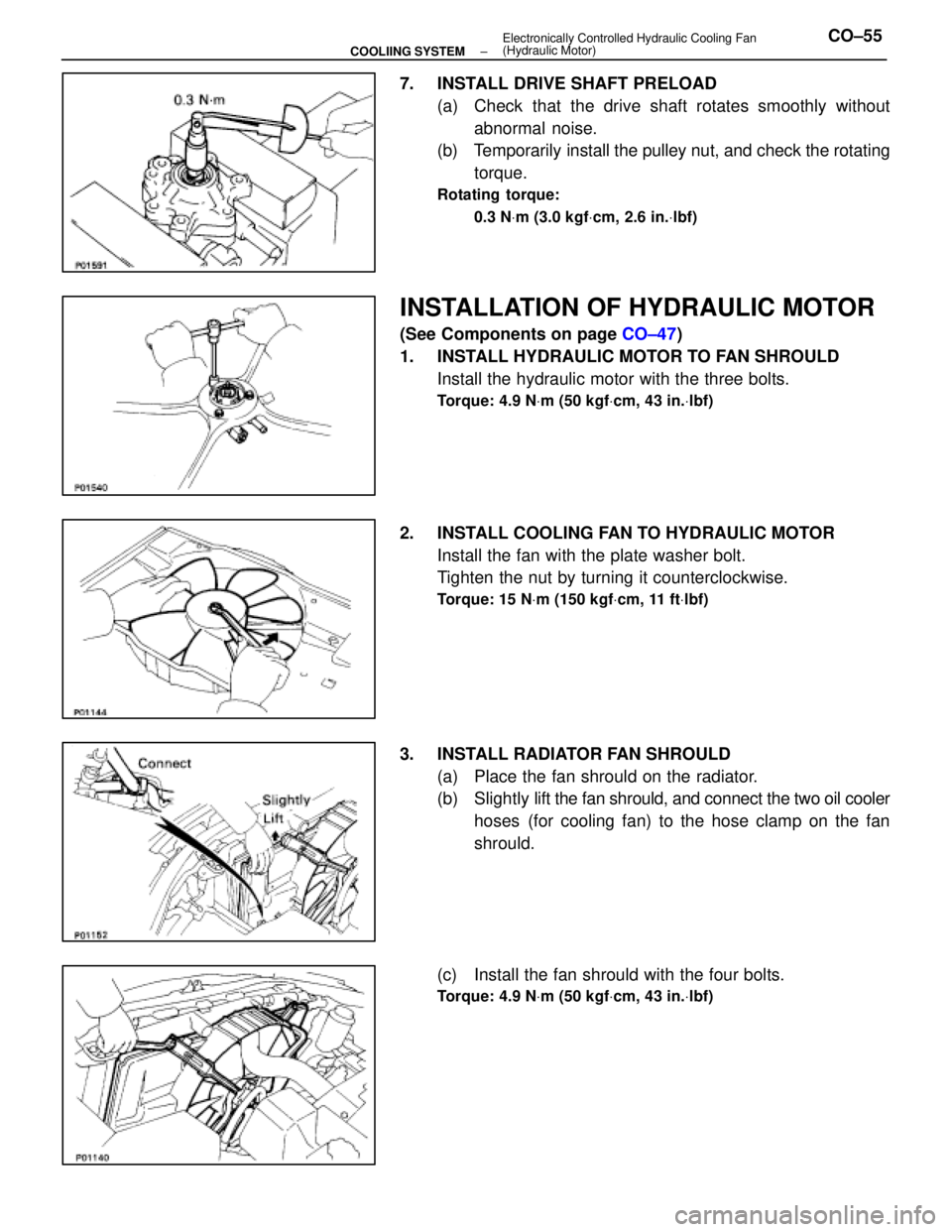Page 1316 of 4087
ASSEMBLY OF HYDRAULIC MOTOR
(See Components on page CO±50)
HINT:
w Thoroughly clean all parts to be assembled.
w Before installing the parts, apply new fluid to all sliding
and rotating surfaces.
1. MOUNT MOTOR HOUSING Slightly mount the motor housing in a vise.
NOTICE: Be careful not to damage the motor housing.
2. INSTALL FRONT THRUST WASHER
3. INSTALL DRIVEN AND DRIVE ROTORS Install the d rive and driven rotors with the dot mark facing up-
ward.
4. INSTALL DRIVE SHAFT
5. INSTALL REAR THRUST WASHER
6. INSTALL MOTOR COVER (a) Install a new O±ring to the motor housing groove.
(b) Install the motor cover with the four bolts.
Torque: 28 N Vm (290 kgf Vcm, 21 ft Vlbf)
CO±54±
COOLIING SYSTEM Electronically Controlled Hydraulic Cooling Fan
(Hydraulic Motor)
WhereEverybodyKnowsYourName
Page 1317 of 4087

7. INSTALL DRIVE SHAFT PRELOAD(a) Check that the drive shaft rotates smoothly withoutabnormal noise.
(b) Temporarily install the pulley nut, and check the rotating
torque.
Rotating torque:
0.3 N Vm (3.0 kgf Vcm, 2.6 in. Vlbf)
INSTALLATION OF HYDRAULIC MOTOR
(See Components on page CO±47)
1. INSTALL HYDRAULIC MOTOR TO FAN SHROULD Install the hydraulic motor with the three bolts.
Torque: 4.9 N Vm (50 kgf Vcm, 43 in. Vlbf)
2. INSTALL COOLING FAN TO HYDRAULIC MOTOR
Install the fan with the plate washer bolt.
Tighten the nut by turning it counterclockwise.
Torque: 15 N Vm (150 kgf Vcm, 11 ft Vlbf)
3. INSTALL RADIATOR FAN SHROULD
(a) Place the fan shrould on the radiator.
(b) Slightly lift the fan shrould, and connect the two oil cooler
hoses (for cooling fan) to the hose clamp on the fan
shrould.
(c) Install the fan shrould with the four bolts.
Torque: 4.9 N Vm (50 kgf Vcm, 43 in. Vlbf)
±
COOLIING SYSTEM Electronically Controlled Hydraulic Cooling Fan
(Hydraulic Motor)CO±55
WhereEverybodyKnowsYourName
Page 1380 of 4087

The 1 UZ±FE engine has 8±cylinders in a V±arrangement at a bank an\
gle of 905. From the front of the RH
bank cylinders are numbered 2 ± 4 ± 6 ± 8, and from the front of t\
he LH bank cylinders are 1 ± 3 ± 5 ± 7.
The crankshaft is supported by 5 bearings inside the crankcase. These beari\
ngs are made of a copper and
lead alloy.
The crankshaft is integrated with 8 weights for balance. Oil holes are plac\
ed in the center of the crankshaft
to supply oil to the connecting rods, bearing, pistons and other component\
s.
The ignition order is 1 ± 8 ± 4 ± 3 ± 6 ± 5 ± 7 ± 2. T\
he cylinder head is made of alminum alloy, with a cross
flow type intake and exhaust layout and with pent±roof type combustion chambers. The spark plugs are
located in the center of the combustion chambers.
At the front and rear of the intake manifold, a water passage has been p\
rovided which connects the RH
and LH cylinder heads.
Exhaust and intake valves are equipped with irregular pitch springs made\
of special valve spring carbon
steel which are capable of functioning at all engine speeds.
The RH and LH intake camshaft are driven by a timing belt, and a gear on\
the intake camshaft engages
with a gear on the exhaust camshaft to drive it. The cam journal is supp\
orted at 5 (intake) or 4 (exhaust)
places between the valve lifters of each cylinder and on the front end o\
f the cylinder head. Lubrication of
the cam journals and gears is accomplished by oil being supplied through th\
e oiler port in the center of the
camshaft.
Adjustment of the valve clearance is done by means of an outer shim type\
system, in which valve adjusting
shims are located above the valve lifters. This permits replacement of the sh\
ims without removal of the
camshafts.
Pistons are made of high temperature±resistant aluminum alloy, and a depression is built into the piston
head to prevent interference with the valves.
Piston pins are the full±floating type, with the pins fastened to neither the piston boss nor the connecting
rods. Instead, snap rings are fitted on both ends of the pins, preventing the\
pins from falling out.
The No.1 compression ring is made of steel and the No.2 compression ring\
is made of cast iron. The oil
ring is made of a combination of steel and stainless steel. The outer diamet\
er of each piston ring is slightly
larger than the diameter of the piston and the flexibility of the rings allows them to hug the cylinder walls
when they are mounted on the piston. Compression rings No.1 and No.2 work to\
prevent gas leakage from
the cylinder and the oil ring works to scrape oil off the cylinder walls to prevent it from entering the combus-
tion chambers.
The cylinder block is made of aluminum alloy with a bank of 90 5. Cast iron cylinders are installed inside
the cylinder block. It has 8 cylinders which are approximately twice the le\
ngth of the piston stroke. The top
of each cylinder is closed off by the cylinder head and the lower end of the cylinders becomes the crank-
case, in which the crankshaft is installed. In addition, the cylinder block c\
ontains a water jacket, through
which coolant is pumped to cool the cylinders.
The No.1 and No.2 oil pans are bolted onto the bottom of the cylinder bl\
ock. The No.1 oil pan is made of
aluminum alloy. The No.2 oil pan is an oil reservoir made of pressed steel sheet. An o\
il level sensor is
installed in the No.1 oil pan (If oil level drops below a set level, a warning light\
s up.). And oil pan baffle plate
keeps sufficient oil in the bottom of the No.2 oil pan even when the vehicle is t\
ilted. This dividing plate also
prevents the oil from marking waves when the vehicle is stopped suddenly\
and the oil shifts away from the
oil pump suction pipe.
Plastic region tighten bolts are used for the cylinder head, main bearin\
g cap and connecting rod.
EG±4
±
1UZ±FE ENGINE ENGINE MECHANICAL
WhereEverybodyKnowsYourName
Page 1386 of 4087

EG0B4±0K
ENGINE OIL INSPECTION
1. CHECK OIL QUALITYCheck the oil for deterioration, entry of water, discoloring or
thinning.
If oil quality is visibly poor, replace the oil.
Oil grade:
API grade SG or SH, Energy±Conserving II or ILSAC
multigrade engine oil. Recommended viscosity is as
shown in the illustration, with SAE 5W±30 being the
preferred engine oil.
Drain and refill capacity: w/ Oil filter change
4.8 liters (5.1 US qts, 4.2 lmp. qts)
w/o Oil filter change
4.5 liters (4.8 US qts, 4.0 lmp. qts)
2. CHECK ENGINE OIL LEVELThe oil level should be between the ªLº and ªFº marks on the
dipstick.
If low, check for leakage and add oil up to the ªFº mark.
EG3E2±01
BATTERY INSPECTION
1. CHECK BATTERY ELECTROYTE LEVEL AND VOLTAGE
(a) Check the electrolyte quantity of each cell.If under the lower level, replace the battery (or add distilled
water if possible.). Need to check the charging system.
(b) Measure the battery voltage between the terminals negative (±) and positive (+) of the battery.
Standard voltage:
12.7±12.9 V at 20 5C (68 5F)
HINT:
w Before measuring the voltage, turn the ignition switch
OFF and turn off the electrical systems (headlight,
blower motor, rear defogger etc.) for 60 seconds to
remove the surface charge.
EG±10
±
1UZ±FE ENGINE ENGINE MECHANICAL
WhereEverybodyKnowsYourName
Page 1408 of 4087

40. RECONNECT NEGATIVE TERMINAL CABLE TOBATTERY
41. REFILL WITH ENGINE COOLANT
42. START ENGINE AND CHECK FOR LEAKS
EG21T±02
IGNITION TIMING INSPECTION
1. REMOVE UPPER HIGH±TENSION CORD COVER
(a) Remove the 2 bolts.
(b) Disconnect the front side claw groove of the upper cord cover
from the claw of lower cord cover, and remove the upper cord
cover.
2. WARM UP ENGINE Allow the engine to warm up to normal operating tempera-
ture.
3. CONNECT TACHOMETER AND TIMING LIGHT TO ENGINE
Connect the tester probe of a tachometer to terminal IG � of
the DLC1.
HINT: Set the tachometer to the 4±cylinder range.
NOTICE:
w Never allow the tachometer terminal to touch ground as
it could result in damage to the igniter and/or ignition
coil.
w As some tachometers are not compatible with this
ignition system, we recommend that you confirm the
compatibility of your unit before use.
4. INSPECT IGNITION TIMING
(a) Using SST, connect terminals TE1 and E1 of the DLC 1.
SST 09843±18020
EG±32
±
1UZ±FE ENGINE ENGINE MECHANICAL
WhereEverybodyKnowsYourName
Page 1409 of 4087

(b) Connect the tester probe of a timing light to the high ±tension
cord for No.6 cylinder.
(c) Using a timing light, check the ignition timing.
Ignition timing: 8 ± 12 5 BTDC @ idle
(Transmission in neutral position)
If the ignition timing is not as specified, check that following
conditions are normal:
w Throttle valve fully closed
w Continuity between terminals IDL1 and E2 of the throttle
position sensor
w Valve timing
(d) Remove the SST from the DLC1. SST 09843±18020
5. DISCONNECT TACHOMETER AND TIMING LIGHT FROM ENGINE
6. REINSTALL UPPER HIGH±TENSION CORD COVER
(a) Fit portion A of the upper high±tension cord cover matching the top of the lower high±tension cord cover.
(b) Push the front side of the upper high±tension cord cover, and
fit the front side claw groove of the upper high±tension cord
cover to the claw of the lower high ±tension cord cover.
(c) Install the upper high±tension cord cover with the 2 bolts.
±
1UZ±FE ENGINE ENGINE MECHANICALEG±33
WhereEverybodyKnowsYourName
Page 1424 of 4087

(e) Slightly lift the radiator, and disconnect the 2 oil cooler hoses(for cooling fan) from the hose clamp on the radiator fan
shroud.
(f) Remove the radiator assembly.
(g) Remove the 2 lower radiator supports from the radiator.
7. DISCONNECT AIR CONDITIONING (A/C) COMPRESSOR
FROM ENGINE
(a) Disconnect the A/C compressor connector.
(b) Remove the nut, and disconnect the ground cable from the
A/C compressor stay.
(c) Remove the bolt and A/C compressor stay.
(d) Remove the 2 bolts, and disconnect the A/C compressor from the engine.
HINT: Put aside the A/C compressor, and suspend it.
8. REMOVE INTAKE AIR CONNECTOR
(a) Disconnect the following hoses: (1) Air hose from IAC valve
(2) Air hose (from air control valve on PS pump) from intake
air connector
(b) Remove the bolt holding the intake air connector to the cylinder head cover.
(c) Loosen the 2 hose clamps.
(d) Disconnect the intake air connector from the throttle body
and air cleaner hose, and remove the intake air connector.
EG±48
±
1UZ±FE ENGINE ENGINE MECHANICAL
WhereEverybodyKnowsYourName
Page 1430 of 4087
wWhen replacing timing belt tensioner only:
To avoid meshing of the timing pulley and timing belt,
secure one of them with string. And place matchmarks
on the timing belt and RH camshaft timing pulley.
Alternately loosen the 2 bolts, and remove them, the belt ten-
sioner and dust boot.
29. DISCONNECT TIMING BELT FROM CAMSHAFT TIMING PULLEYS
(a) Using SST, loosen the tension spring between the LH and RH
camshaft timing pulleys by slightly turning the LH camshaft
timing pulley clockwise.
SST 09278±54012
(b) Disconnect the timing belt from the camshaft timing pulleys.
30. REMOVE CAMSHAFT TIMING PULLEYS Using SST, remove the bolt and timing pulley. Remove the 2
timing pulleys.
SST 09278±54012
EG±54
±
1UZ±FE ENGINE ENGINE MECHANICAL
WhereEverybodyKnowsYourName